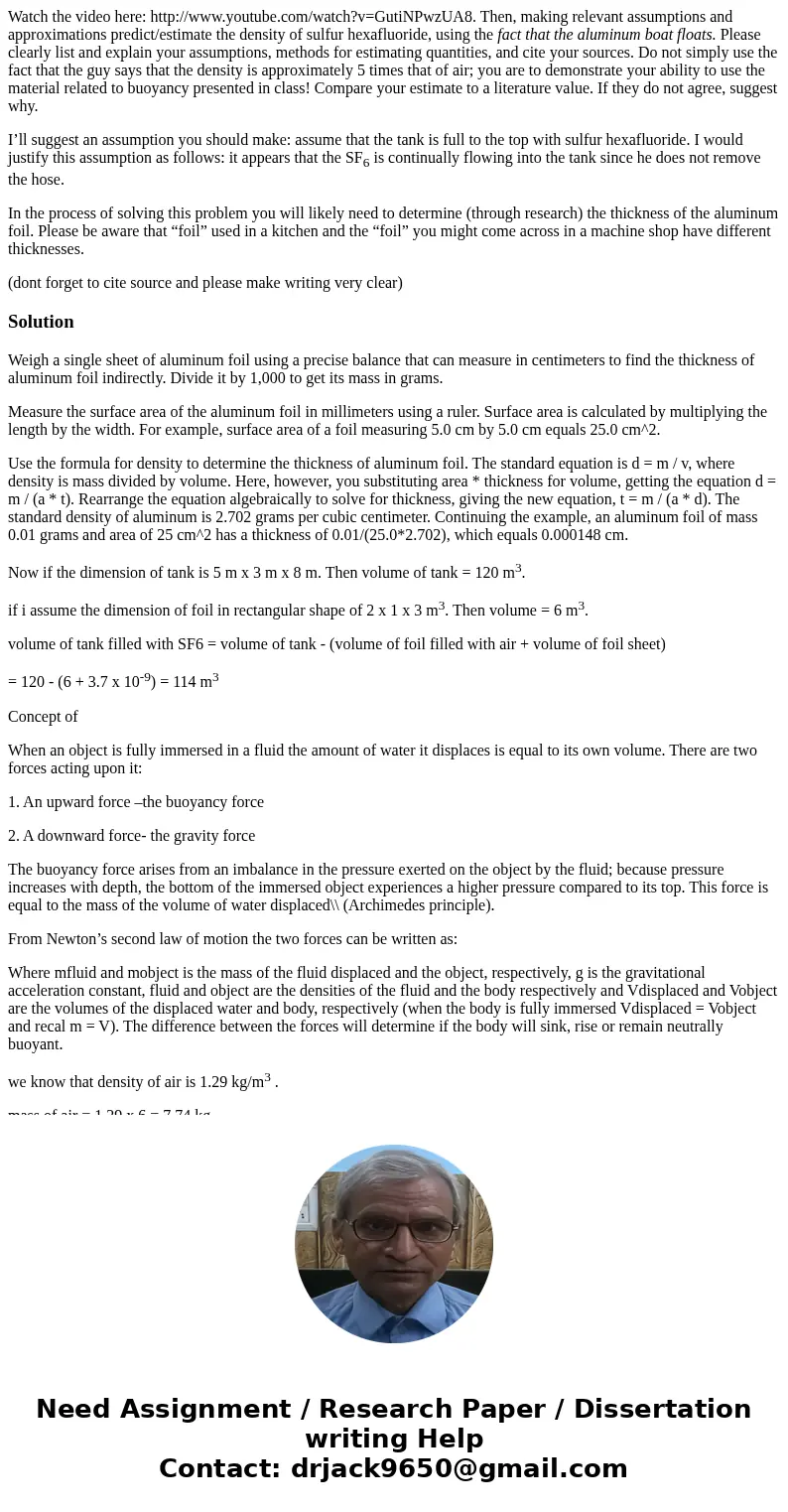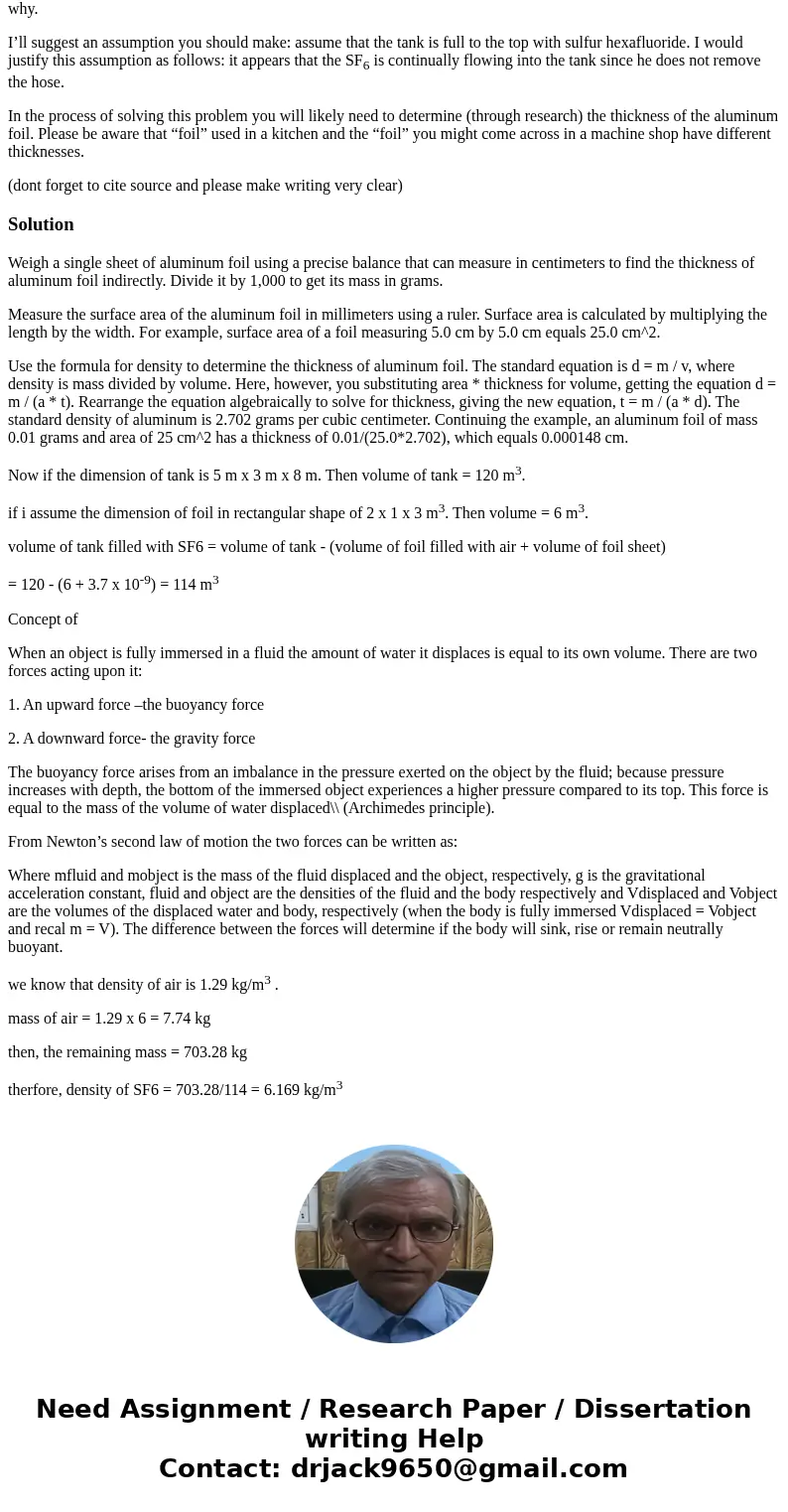Watch the video here httpwwwyoutubecomwatchvGutiNPwzUA8 Then
Watch the video here: http://www.youtube.com/watch?v=GutiNPwzUA8. Then, making relevant assumptions and approximations predict/estimate the density of sulfur hexafluoride, using the fact that the aluminum boat floats. Please clearly list and explain your assumptions, methods for estimating quantities, and cite your sources. Do not simply use the fact that the guy says that the density is approximately 5 times that of air; you are to demonstrate your ability to use the material related to buoyancy presented in class! Compare your estimate to a literature value. If they do not agree, suggest why.
I’ll suggest an assumption you should make: assume that the tank is full to the top with sulfur hexafluoride. I would justify this assumption as follows: it appears that the SF6 is continually flowing into the tank since he does not remove the hose.
In the process of solving this problem you will likely need to determine (through research) the thickness of the aluminum foil. Please be aware that “foil” used in a kitchen and the “foil” you might come across in a machine shop have different thicknesses.
(dont forget to cite source and please make writing very clear)
Solution
Weigh a single sheet of aluminum foil using a precise balance that can measure in centimeters to find the thickness of aluminum foil indirectly. Divide it by 1,000 to get its mass in grams.
Measure the surface area of the aluminum foil in millimeters using a ruler. Surface area is calculated by multiplying the length by the width. For example, surface area of a foil measuring 5.0 cm by 5.0 cm equals 25.0 cm^2.
Use the formula for density to determine the thickness of aluminum foil. The standard equation is d = m / v, where density is mass divided by volume. Here, however, you substituting area * thickness for volume, getting the equation d = m / (a * t). Rearrange the equation algebraically to solve for thickness, giving the new equation, t = m / (a * d). The standard density of aluminum is 2.702 grams per cubic centimeter. Continuing the example, an aluminum foil of mass 0.01 grams and area of 25 cm^2 has a thickness of 0.01/(25.0*2.702), which equals 0.000148 cm.
Now if the dimension of tank is 5 m x 3 m x 8 m. Then volume of tank = 120 m3.
if i assume the dimension of foil in rectangular shape of 2 x 1 x 3 m3. Then volume = 6 m3.
volume of tank filled with SF6 = volume of tank - (volume of foil filled with air + volume of foil sheet)
= 120 - (6 + 3.7 x 10-9) = 114 m3
Concept of
When an object is fully immersed in a fluid the amount of water it displaces is equal to its own volume. There are two forces acting upon it:
1. An upward force –the buoyancy force
2. A downward force- the gravity force
The buoyancy force arises from an imbalance in the pressure exerted on the object by the fluid; because pressure increases with depth, the bottom of the immersed object experiences a higher pressure compared to its top. This force is equal to the mass of the volume of water displaced\\ (Archimedes principle).
From Newton’s second law of motion the two forces can be written as:
Where mfluid and mobject is the mass of the fluid displaced and the object, respectively, g is the gravitational acceleration constant, fluid and object are the densities of the fluid and the body respectively and Vdisplaced and Vobject are the volumes of the displaced water and body, respectively (when the body is fully immersed Vdisplaced = Vobject and recal m = V). The difference between the forces will determine if the body will sink, rise or remain neutrally buoyant.
we know that density of air is 1.29 kg/m3 .
mass of air = 1.29 x 6 = 7.74 kg
then, the remaining mass = 703.28 kg
therfore, density of SF6 = 703.28/114 = 6.169 kg/m3


 Homework Sourse
Homework Sourse